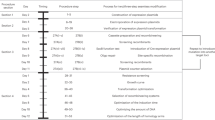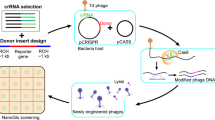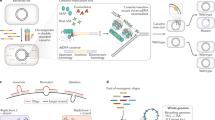Abstract
Efficient genome editing methods are essential for biotechnology and fundamental research. Homologous recombination (HR) is the most versatile method of genome editing, but techniques that rely on host RecA-mediated pathways are inefficient and laborious. Phage-encoded single-stranded DNA annealing proteins (SSAPs) improve HR 1,000-fold above endogenous levels. However, they are not broadly functional. Using Escherichia coli, Lactococcus lactis, Mycobacterium smegmatis, Lactobacillus rhamnosus and Caulobacter crescentus, we investigated the limited portability of SSAPs. We find that these proteins specifically recognize the C-terminal tail of the host’s single-stranded DNA-binding protein (SSB) and are portable between species only if compatibility with this host domain is maintained. Furthermore, we find that co-expressing SSAPs with SSBs can significantly improve genome editing efficiency, in some species enabling SSAP functionality even without host compatibility. Finally, we find that high-efficiency HR far surpasses the mutational capacity of commonly used random mutagenesis methods, generating exceptional phenotypes that are inaccessible through sequential nucleotide conversions.

This is a preview of subscription content, access via your institution
Access options
Access Nature and 54 other Nature Portfolio journals
Get Nature+, our best-value online-access subscription
$29.99 / 30 days
cancel any time
Subscribe to this journal
Receive 12 print issues and online access
$259.00 per year
only $21.58 per issue
Buy this article
- Purchase on Springer Link
- Instant access to full article PDF
Prices may be subject to local taxes which are calculated during checkout





Similar content being viewed by others
Data availability
NGS data for the L. lactis spectinomycin experiment are deposited as a NCBI BioProject under accession no. PRJNA648295. All data and constructs are available from the authors upon reasonable request. For L. rhamnosus plasmids, contact the corresponding authors or anik@tenza.bio. Source data are provided with this paper.
Code availability
The scripts used to analyze doubling times in MATLAB, analyze Illumina sequencing data and generate the adjacency matrix for the force-directed graph are available upon request.
References
Kelsic, E. D. et al. RNA structural determinants of optimal codons revealed by MAGE-Seq. Cell Syst. 3, 563–571 (2016).
Sharon, E. et al. Functional genetic variants revealed by massively parallel precise genome editing. Cell 175, 544–557 (2018).
Warrier, T. et al. N-methylation of a bactericidal compound as a resistance mechanism in Mycobacterium tuberculosis. Proc. Natl Acad. Sci. USA 113, E4523–E4530 (2016).
Riglar, D. T. et al. Engineered bacteria can function in the mammalian gut long-term as live diagnostics of inflammation. Nat. Biotechnol. 35, 653–658 (2017).
Steidler, L. et al. Biological containment of genetically modified Lactococcus lactis for intestinal delivery of human interleukin 10. Nat. Biotechnol. 21, 785–789 (2003).
Guo, C.-J. et al. Depletion of microbiome-derived molecules in the host using Clostridium genetics. Science 366, eaav1282 (2019).
Chen, P. E. & Shapiro, B. J. The advent of genome-wide association studies for bacteria. Curr. Opin. Microbiol. 25, 17–24 (2015).
Murphy, K. C. et al. ORBIT: a new paradigm for genetic engineering of Mycobacterial chromosomes. mBio 9, e01467–18 (2018).
Wang, H. H. et al. Programming cells by multiplex genome engineering and accelerated evolution. Nature 460, 894–898 (2009).
Garst, A. D. et al. Genome-wide mapping of mutations at single-nucleotide resolution for protein, metabolic and genome engineering. Nat. Biotechnol. 35, 48–55 (2017).
Lajoie, M. J. et al. Genomically recoded organisms expand biological functions. Science 342, 357–360 (2013).
Fredens, J. et al. Total synthesis of Escherichia coli with a recoded genome. Nature 569, 514–518 (2019).
Yu, D. et al. An efficient recombination system for chromosome engineering in Escherichia coli. Proc. Natl Acad. Sci. USA 97, 5978–5983 (2000).
Jiang, W., Bikard, D., Cox, D., Zhang, F. & Marraffini, L. A. RNA-guided editing of bacterial genomes using CRISPR-Cas systems. Nat. Biotechnol. 31, 233–239 (2013).
Oh, J.-H. & van Pijkeren, J.-P. CRISPR–Cas9-assisted recombineering in Lactobacillus reuteri. Nucleic Acids Res. 42, e131 (2014).
Corts, A. D., Thomason, L. C., Gill, R. T. & Gralnick, J. A. Efficient and precise genome editing in Shewanella with recombineering and CRISPR/Cas9-mediated counter-selection. ACS Synth. Biol. 8, 1877–1889 (2019).
Murphy, K. C. Use of bacteriophage λ recombination functions to promote gene replacement in Escherichia coli. J. Bacteriol. 180, 2063–2071 (1998).
Iyer, L. M., Koonin, E. V. & Aravind, L. Classification and evolutionary history of the single-strand annealing proteins, RecT, Redbeta, ERF and RAD52. BMC Genomics 3, 8 (2002).
Datsenko, K. A. & Wanner, B. L. One-step inactivation of chromosomal genes in Escherichia coli K-12 using PCR products. Proc. Natl Acad. Sci. USA 97, 6640–6645 (2000).
Zhang, Y., Buchholz, F., Muyrers, J. P. P. & Stewart, A. F. A new logic for DNA engineering using recombination in Escherichia coli. Nat. Genet. 20, 123–128 (1998).
Ellis, H. M., Yu, D., DiTizio, T. & Court, D. L. High efficiency mutagenesis, repair and engineering of chromosomal DNA using single-stranded oligonucleotides. Proc. Natl Acad. Sci. USA 98, 6742–6746 (2001).
Wang, K. et al. Defining synonymous codon compression schemes by genome recoding. Nature 539, 59–64 (2016).
Nyerges, Á. et al. Directed evolution of multiple genomic loci allows the prediction of antibiotic resistance. Proc. Natl Acad. Sci. USA 115, E5726–E5735 (2018).
Podgornaia, A. I. & Laub, M. T. Protein evolution. Pervasive degeneracy and epistasis in a protein–protein interface. Science 347, 673–677 (2015).
Halperin, S. O. et al. CRISPR-guided DNA polymerases enable diversification of all nucleotides in a tunable window. Nature 560, 248–252 (2018).
Nyerges, Á. et al. A highly precise and portable genome engineering method allows comparison of mutational effects across bacterial species. Proc. Natl Acad. Sci. USA 113, 2502–2507 (2016).
Hall, S. D., Kane, M. F. & Kolodner, R. D. Identification and characterization of the Escherichia coli RecT protein, a protein encoded by the recE region that promotes renaturation of homologous single-stranded DNA. J. Bacteriol. 175, 277–287 (1993).
van Pijkeren, J.-P. & Britton, R. A. High efficiency recombineering in lactic acid bacteria. Nucleic Acids Res. 40, e76 (2012).
Datta, S., Costantino, N., Zhou, X. & Court, D. L. Identification and analysis of recombineering functions from Gram-negative and Gram-positive bacteria and their phages. Proc. Natl Acad. Sci. USA 105, 1626–1631 (2008).
van Kessel, J. C. & Hatfull, G. F. Recombineering in Mycobacterium tuberculosis. Nat. Methods 4, 147–152 (2007).
Costantino, N. & Court, D. L. Enhanced levels of λ Red-mediated recombinants in mismatch repair mutants. Proc. Natl Acad. Sci. USA 100, 15748–15753 (2003).
Thomason, L. C., Costantino, N. & Court, D. L. Examining a DNA replication requirement for bacteriophage λ Red- and Rac prophage RecET-promoted recombination in Escherichia coli. mBio 7, e01443–16 (2016).
Caldwell, B. J. et al. Crystal structure of the Redβ C-terminal domain in complex with λ exonuclease reveals an unexpected homology with λ ORF and an interaction with Escherichia coli single stranded DNA binding protein. Nucleic Acids Res. 47, 1950–1963 (2019).
Lo Piano, A., Martínez-Jiménez, M. I., Zecchi, L. & Ayora, S. Recombination-dependent concatemeric viral DNA replication. Virus Res. 160, 1–14 (2011).
Yin, J. et al. Single-stranded DNA-binding protein and exogenous RecBCD inhibitors enhance phage-derived homologous recombination in Pseudomonas. iScience 14, 1–14 (2019).
Shereda, R. D., Kozlov, A. G., Lohman, T. M., Cox, M. M. & Keck, J. L. SSB as an organizer/mobilizer of genome maintenance complexes. Crit. Rev. Biochem. Mol. Biol. 43, 289–318 (2008).
Sun, Z. et al. A high-efficiency recombineering system with PCR-based ssDNA in Bacillus subtilis mediated by the native phage recombinase GP35. Appl. Microbiol. Biotechnol. 99, 5151–5162 (2015).
Wannier, T. M. et al. Improved bacterial recombineering by parallelized protein discovery. Proc. Natl Acad. Sci. USA 117, 13689–13698 (2020).
Murphy, K. C., Papavinasasundaram, K. & Sassetti, C. M. Mycobacterial recombineering. Methods Mol. Biol. 1285, 177–199 (2015).
Amiram, M. et al. Evolution of translation machinery in recoded bacteria enables multi-site incorporation of nonstandard amino acids. Nat. Biotechnol. 33, 1272–1279 (2015).
Sawitzke, J. A. et al. Probing cellular processes with oligo-mediated recombination; using knowledge gained to optimize recombineering. J. Mol. Biol. 407, 45–59 (2011).
Unemo, M. et al. Neisseria gonorrhoeae strain with high-level resistance to spectinomycin due to a novel resistance mechanism (mutated ribosomal protein S5) verified in Norway. Antimicrob. Agents Chemother. 57, 1057–1061 (2013).
Miton, C. M. & Tokuriki, N. How mutational epistasis impairs predictability in protein evolution and design. Protein Sci. 25, 1260–1272 (2016).
Schmiedel, J. M. & Lehner, B. Determining protein structures using deep mutagenesis. Nat. Genet. 51, 1177–1186 (2019).
Rollins, N. J. et al. Inferring protein 3D structure from deep mutation scans. Nat. Genet. 51, 1170–1176 (2019).
Fu, J. et al. Full-length RecE enhances linear–linear homologous recombination and facilitates direct cloning for bioprospecting. Nat. Biotechnol. 30, 440–446 (2012).
Raghunathan, S., Kozlov, A. G., Lohman, T. M. & Waksman, G. Structure of the DNA binding domain of E. coli SSB bound to ssDNA. Nat. Struct. Biol. 7, 648–652 (2000).
Borovinskaya, M. A., Shoji, S., Holton, J. M., Fredrick, K. & Cate, J. H. D. A steric block in translation caused by the antibiotic spectinomycin. ACS Chem. Biol. 2, 545–552 (2007).
Choe, W., Chandrasegaran, S. & Ostermeier, M. Protein fragment complementation in M.HhaI DNA methyltransferase. Biochem. Biophys. Res. Commun. 334, 1233–1240 (2005).
Thanbichler, M., Iniesta, A. A. & Shapiro, L. A comprehensive set of plasmids for vanillate- and xylose-inducible gene expression in Caulobacter crescentus. Nucleic Acids Res. 35, e137 (2007).
Lohman, T. M., Green, J. M. & Beyer, R. S. Large-scale overproduction and rapid purification of the Escherichia coli ssb gene product. Expression of the ssb gene under λ PL control. Biochemistry 25, 21–25 (1986).
The PyMOL Molecular Graphics System v.1.8 (Schrodinger LLC, 2015).
Acknowledgements
We thank G. Kuznetsov and G. Squyres for reviewing the manuscript and providing helpful feedback. We thank C. Bell for discussions about possible mechanisms of recombineering and J.P. Van Pijkeren along with J.-H. Oh for helping us set up the initial protocols for L. lactis. This work was supported by the National Institute of General Medical Sciences under grant no. 1U01GM110714-01 and the Department of Energy with DE-FG02-02ER63445 to G.M.C. This work was also supported by NIH grant no. R01GM082899 to M.T.L., who is an Investigator of the Howard Hughes Medical Institute. G.T.F. was supported by the National Science Foundation Graduate Research Fellowship under grant no. DGE1745303. D.A.S. was supported by a Landry Cancer Biology Research Fellowship. K.G. was supported by the National Science Foundation Graduate Research Fellowship under grant no. DGE1745302.
Author information
Authors and Affiliations
Contributions
G.T.F., T.M.W. and G.M.C. conceived the study. X.R., C.J.G. and M.J.L. contributed to project conception. G.T.F. designed the bacterial experiments. T.M.W., F.B.P., I.D.L., J.Z., K.G. and A.D. contributed to bacterial experimental design. G.T.F., F.B.P., I.D.L. and J.Z. carried out the experiments in E. coli, L. lactis, M. smegmatis, C. crescentus and L. rhamnosus and analyzed the data. D.A.S. performed bioinformatic analysis and K.G. performed C. crescentus experiments under the supervision of M.T.L. T.M.W. designed and performed the oligonucleotide annealing experiments. A.D. contributed to experiments in L. rhamnosus. H.K., V.V. and S.W. contributed to the bacterial experiments. G.T.F. wrote the manuscript with input from all other authors. G.T.F. and F.B.P. generated the figures. S.L.S. and J.A. provided supervision. G.M.C. supervised the study.
Corresponding authors
Ethics declarations
Competing interests
G.M.C. is a founder of 64-x, enEvolv and GRO Biosciences. G.T.F., T.M.W. and G.M.C. are named inventors on a patent application related to the technologies described in this Article. Other potentially relevant financial interests are listed at http://arep.med.harvard.edu/gmc/tech.html.
Additional information
Publisher’s note Springer Nature remains neutral with regard to jurisdictional claims in published maps and institutional affiliations.
Extended data
Extended Data Fig. 1 Bicistronic RBS optimization.
In L. lactis, the internal RBS sequence affected recombination efficiency using the bicistronic λ-Red β and EcSSB construct. a, b, RBS 2, which enabled the highest efficiency genome editing in this experiment was selected used in all other constructs unless otherwise indicated. Error bars indicate s.d. from the mean of at least four biologically independent replicates.
Extended Data Fig. 2 Doubling times in E. coli of constructs expressing SSAPs and SSBs reveal that co-expression of SSB can dramatically influence toxicity.
a, Growth curve of cognate SSAP-SSB pairs and SSAPs alone in E. coli under constant induction (7hrs). b, Doubling time measurements for all combinations of the 4 SSAPs and SSBs in E. coli under constant induction (7hrs) with mean and s.d. presented for at least 3 biologically independent replicates. The SSAPs vary in toxicity, with λ-Red β showing considerable toxicity. The co-expression of SSBs reduces SSAP toxicity in a number of cases, especially for PaSSB. There are a number of constructs with low toxicity and high genome editing efficiency (λ-Red β + EcSSB, λ-Red β + PaSSB, PapRecT + PaSSB) showing that there is no direct correlation between toxicity and genome editing efficiency.
Extended Data Fig. 3 Optimization of recombineering efficiency in L. lactis.
a, Optimization of nisin concentration to 10 ng/ml contributed to a significant improvement in genome editing efficiency for PapRecT + PaSSB. a, The optimal oligo amount plateaued at 50 μg of DNA, which corresponds 21.4 μM in 80 μL. b, Expression of the L. lactis MutL variant E33K allowed the efficient introduction of 1 bp mismatches at similar efficiency to 4 bp mismatches which evade MMR. c, d, After optimization from (a, b), PapRecT + PaSSB + LlMutLE33K enabled >20% editing efficiency at the Rif locus (c), and efficient multiplexed editing (d). Error bars indicate s.d. from the mean of at least three biologically independent replicates. b, *: P value < .05; ordinary one-way ANOVA of Log-transformed data, Holm-Sidak multiple comparisons test.
Extended Data Fig. 4 DsDNA recombineering with PapRecT and PaSSB in L. lactis.
Although this work mostly focused on ssDNA recombineering, dsDNA recombineering can be used to integrate larger constructs including genes and resistance markers, and usually requires the presence of a cognate phage exonuclease. These proteins are almost always found within the phage operon containing the SSAP, and can be readily co-expressed to enable dsDNA recombineering. Surprisingly, we find that PapRecT + PaSSB enabled dsDNA recombineering in L. lactis even without including a cognate phage exonuclease suggesting that the co-expressed SSB recruits an endogenous exonuclease, or the SSAP+SSB pair provides the sufficient requirements for dsDNA recombineering. (a) Gene knockins were performed in L. lactis using linear DNA with 500 bp homology arms carrying an Erythromycin resistance cassette. (b) Co-expression of PapRecT + PaSSB enabled the efficient introduction of a 1 kb selectable marker as dsDNA even without the addition of the cognate phage exonuclease. Error bars indicate s.d. from the mean of at least three biologically independent replicates.
Extended Data Fig. 5 Heat maps of RpsE mutagenesis at different mutational depths.
The 5NNK library diversification experiment (Fig. 5) allow us to identify antibiotic resistant single, double, triple, or quintuple mutants when the other codons have WT amino acids. (a) heat maps showing the enrichment of amino acids in the 5NNK library, filtered to separately present those with 1, 2, 3, or 4 mutations vs. WT. The enriched amino acids change at increasing mutational depth. The “5NNK: 1 mutation” library has mutations enriched in the first 2 positions (28 V, and 29 K) similar to the 5x1NNK single-amino acid mutagenesis heat map, while the “5NNK: 4 mutation” library looks similar to the 5NNK library heat map (Fig. 5b), with an enrichment to polar and charged residues at all 5 positions.
Supplementary information
Supplementary Information
Supplementary Note and Figs. 1–12.
Source data
Source Data Fig. 1
Statistical source data.
Source Data Fig. 2
Statistical source data
Source Data Fig. 3
Statistical source data.
Source Data Fig. 4
Statistical source data.
Source Data Fig. 5
Statistical source data for heat maps.
Rights and permissions
About this article
Cite this article
Filsinger, G.T., Wannier, T.M., Pedersen, F.B. et al. Characterizing the portability of phage-encoded homologous recombination proteins. Nat Chem Biol 17, 394–402 (2021). https://doi.org/10.1038/s41589-020-00710-5
Received:
Revised:
Accepted:
Published:
Issue Date:
DOI: https://doi.org/10.1038/s41589-020-00710-5
This article is cited by
-
Bacterial genome engineering using CRISPR-associated transposases
Nature Protocols (2024)
-
Engineered bacterial orthogonal DNA replication system for continuous evolution
Nature Chemical Biology (2023)
-
Recombineering-Mediated Sinorhizobium meliloti Rm1021 Gene Deletion
Current Microbiology (2023)
-
A multifunctional system for genome editing and large-scale interspecies gene transfer
Nature Communications (2022)
-
Towards next-generation cell factories by rational genome-scale engineering
Nature Catalysis (2022)



